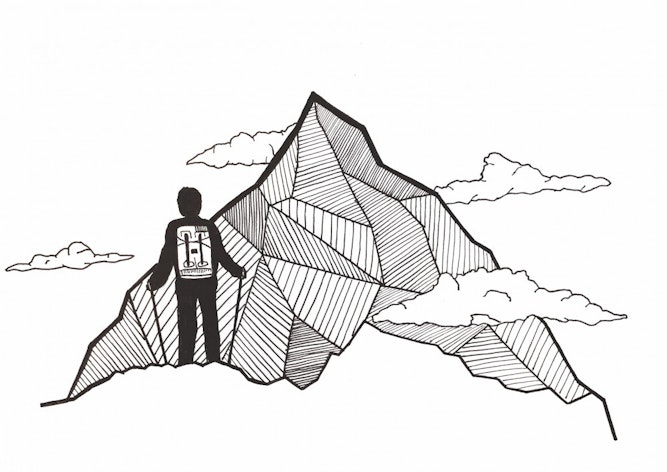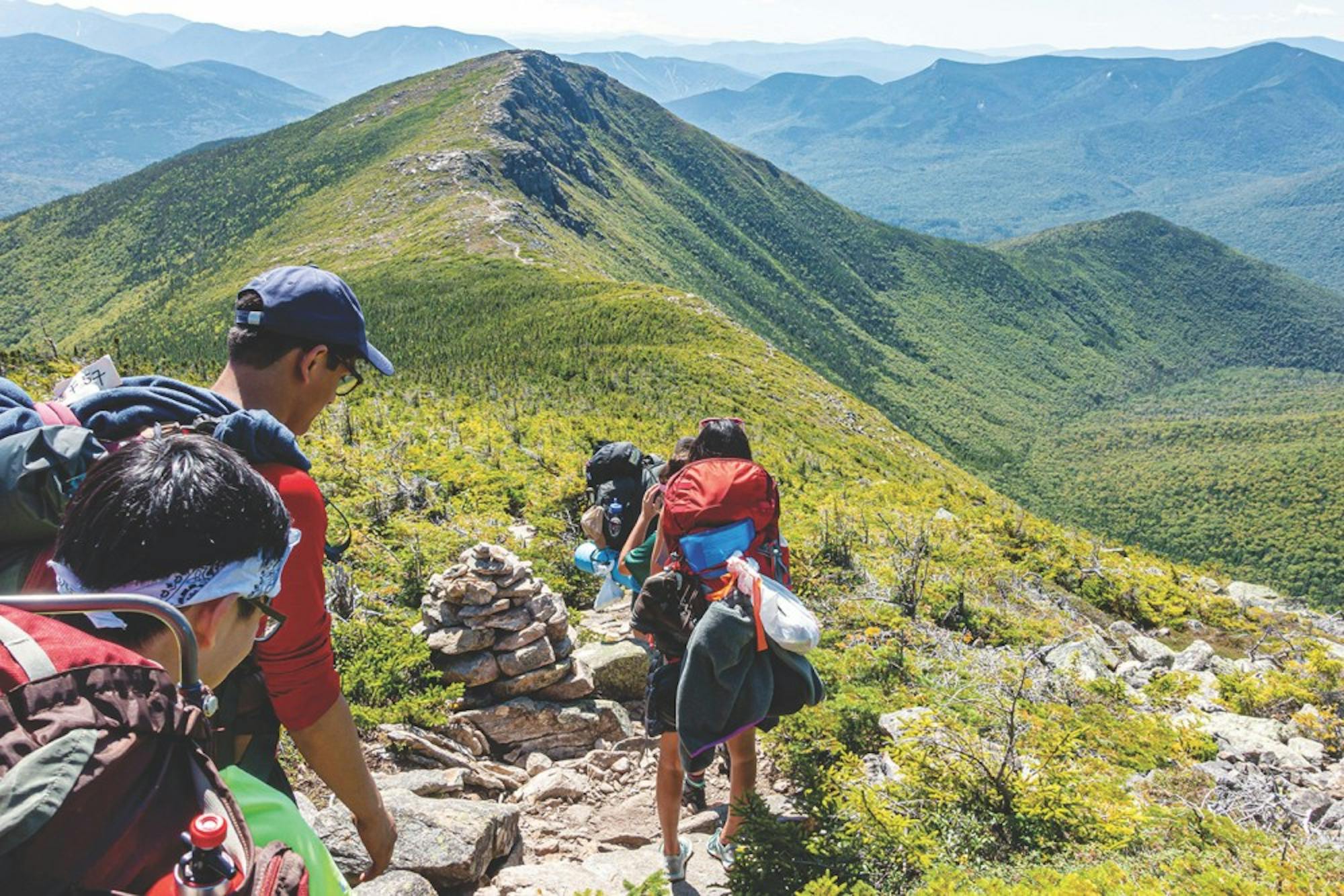In August and September, members of the College’s incoming class arrive on campus for First-Year Trips, a five-day outdoor program run by students before orientation week. Trips, officially run by the Dartmouth Outing Club, involves over 90 percent of the incoming class and includes over 300 student volunteers. It has roots that can be traced to humble beginnings over 90 years ago. In the near-century that has passed, the program has undergone numerous changes to shape it into its current form.
According to “Reaching That Peak: 75 years of the Dartmouth Outing Club,” the first First-Year Trip was planned in 1935 after seniors on the then-highly popular “Senior Trips” program to Mount Washington expressed regret over not becoming involved with the DOC earlier.
The inaugural trips went out that fall in September 1935, with the stated goal to introduce freshmen to the DOC so that they “might be a swell advance guard on talking up the Club to the rest of the class.”
Maddy Waters ’19 is the director of Trips this year. She shares a temporary office with associate director of Trips Dorothy Qu ’19 GR’20 on the second floor of the Collis Center in an office tucked at the end of the hallway. A large calendar of the month of August with important dates in preparation for Trips dominates the room.
College archivist Peter Carini noted that in the 1930s, membership in the DOC was declining, and the Trips program was a great way for the club to attract new members. Thus, the first year of Trips, each freshman received a notice that the DOC intended to take freshmen, “over the Moosilauke Range, with its wild ravines, and over Franconia Range, a magnificent set of mountains.”
The packing list suggested a pair of dungarees and noted, “If the sun affects you, add one old hat.”

Derek Lue / The Dartmouth
While First-Year Trips still do include hiking — now split into four levels based on difficulty — the types of trips offered has expanded over the years. For example, Waters went on the horseback riding trip her freshman year while Qu went white water kayaking during hers.
Rory Gawler ’05, general manager of the DOC, noted that many of the new trips reflect the growth of the DOC itself, which has expanded by adding new “sub-clubs” that specialize in certain outdoor activities, such as the climbing club and the mountain biking club.
“We have mountain biking trips in part because we have an active mountain biking club and we have student leaders who are active in that,” he said.
The relationship between DOC sub-clubs and their respective trips is key to success of trips as a whole, Gawler said. He added that this relationship allows leaders within sub clubs to teach technical and safety skills, leaving trip leaders to focus on interacting with freshmen.
According to Qu, when she led a Hiking II trip her sophomore year, it was her second time ever hiking.
“It was scary,” she said. “But I think Trips does a good job of helping beginners because I learned a lot during [leader] trainings.”
Computer science professor David Kotz ’86 served as Trips director his senior year while completing his undergraduate studies. He said that the most unique trip he saw attempted was a trip to Boston catered for people without a background in the outdoors.
“We actually set up trips to Boston and had them walking the Freedom Trail and seeing the sites,” he said. “That was a disaster. We did [the trip] one year and it was not deemed either logistically feasible or enjoyable.”
Several other changes have also occurred in the time since the first trip went out. Among the most notable is the number of freshmen that participate in the program. As late as 1970, only about half of the incoming student body went on First- Year Trips, according to Gawler.
“There was a sort of an inflection point in the say early ’80s, late ’70s, where the program had grown to a sort of an awkward size where it’s much of the campus but not most of the campus,” Gawler said.
According to Waters, at a certain point the program was changed to reflect and attract a wider audience as trip participation grew.
With this increased population of “trippees,” or participants in the Trips program, came a required expansion to the organization capacity of the First-Year Trips program as well. In 1983, the program was computerized for the first time. Kotz wrote the code for the original program for tracking trippees and trips his freshman spring and noted that he still has the magnetic tape reel containing the code.
Trips also used to recruit faculty members to act as trip leaders. According to Waters, the practice was discontinued once Trips became large enough that faculty trip leaders were no longer necessary.
“Dartmouth enjoys the unique reputation of organizing one of the most unusual introductions to college for incoming freshman,” wrote John H. Graham, Jr. ’76, the 1975 director of First-Year Trips, in a letter to College administration and faculty. “The overwhelming success of this program has been attributed to the numerous College officers, faculty, and staff who have participated.”
Kotz, who also served as faculty trip leader on multiple occasions, recalled reviewing faculty trip leader applications while he was Trips director in 1986.
“[Faculty] would apply like anyone else, and the Trips director would decide whether that person had the relevant skills and aptitude,” he said. “I remember, as a senior, finding it quite interesting that I had the power to accept or reject the faculty applications.”
Another more recent shift was the creation of many positions within the Trips directorate to help facilitate Trips. According to Gawler, when he was an undergraduate at the College, there was little organization beyond the Director of Trips and the leaders. Now, however, there are positions such as the “Vox Croo,” which organizes safety logistics, other “Croos” and trip leader trainers.
“Every detail is thought about and managed to a degree that one person 20 years ago just could not possibly have done,” he said.
Kotz served as Hanover Croo chief his junior year. While he said that many of the same traditions remain — such as the “silliness” meant to reduce anxiety among the freshmen — structurally, the different crews have grown and become more organized since his time.
“[Hanover Croo] was just whoever was around that day,” he said. “Some days you’d have six people and some days you’d have 16.”
“Croolings,” or members of Croos, also have not always received meals or housing from the College, according to Kotz. He added that Hanover Croo would ask trippees, who would get a meal provided for them through College dining, to smuggle out food for them.
One of the biggest changes to Trips came in 1972, when the College began admitting women. According to Ed McNierney ’80, the skewed ratio between women and men in the first years when the College began admitting women meant that not all trips were co-ed.
“My bicycle trip was in Section G, the last section, so I had the ‘privilege’ of being on the last all-male Freshman Trips group at the Lodge,” he wrote in an email to The Dartmouth.
With a new Trips directorate chosen each year, changes to First- Year Trips occur on a yearly basis. This year, the Trips directorate has focused on broadening the experience to accommodate the needs of more participants. This includes additions such as eating disorder and mental health education for leaders and encouraging leaders to check in with their trippees individually. A new trip, called “Explore the Upper Valley,” was also implemented, according to Waters.
She added that the trip will be using a wheelchair accessible cabin, and trippees will be shuttled around by volunteers and visit different parts of the Upper Valley that have historical value.
Regardless of how many changes are implemented to Trips, the most important part of Trips remains the interactions within each trip, according to Gawler.
“The core of the program is when the students are out on their trip with their trip leaders in their trip group,” he said. “That’s when the real bonds form.”
According to Carini, the Trips program is a phenomenon unique to Dartmouth that other colleges look to. He recalled that when he began working at the College, colleagues at other institutions asked him what the “Dartmouth secret” to Trips was.
“A lot of institutions are very impressed with how Dartmouth manages a tight-knit alumni base, and a lot of that is attributed to Trips,” he said.
To Kotz, the main goal of Trips has always been the same: to make incoming students comfortable and prepare them for orientation.
“What Trips does, when it does its best, is help students who are really nervous about entering college and leaving home,” Kotz said. “When they come back [from Trips], you can see it in their faces when they get off that bus. They know a few people; they feel more comfortable; they’re ready to enter orientation in college. That transition is the real value of the program.”
Dorothy Qu is a member of The Dartmouth staff.
This article is a part of the 2019 Freshman Issue.
Correction appended (August 31, 2019): An earlier version of this article misspelled Ed McNierney's last name.


